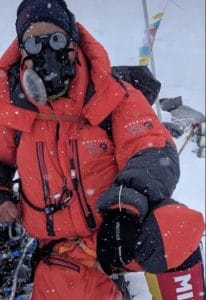A pulse oximeter shows blood oxygen saturation (SpO2), which provides insight to how well a person’s heart and lungs are working. Levels between 94 and 99 percent are considered normal for most people. Lower levels are associated with conditions that range from asthma and chronic obstructive pulmonary disease to anemia or congenital heart defects. That information is also useful in low-oxygen situations, such as high altitudes.
Blood Oxygen Saturation (SpO2) and Altitude
Risk of hypoxia makes mountain climbing difficult and dangerous, even for healthy people. Oxygen depletion can cause altitude sickness, which usually begins as nausea and dizziness. Unless the climber descends to a lower altitude or uses supplemental oxygen, the symptoms can grow worse—and quickly. Conditions known as high-altitude cerebral edema (HACE) and high-altitude pulmonary edema (HAPE) often result in coma or death.
Above 8,000 meters (26,000 feet), the atmosphere has too little oxygen to support human life. Climbers who plan to reach those heights bring supplemental oxygen, but still risk hypoxia. Oxygen cylinders add weight, making the climb more difficult, so people carry as few as possible. If they use too little oxygen, they get symptoms of altitude sickness; if they use too much, they run out. At least a dozen climbers died this year alone on Mount Everest.
Supplemental Oxygen and SpO2 Monitoring
As founder of WiCis, Dr. Leo Montejo develops systems that monitor health data and share that information remotely. He extends the use of eHealth technologies beyond diagnosis of distant patients to real-time tracking of adventurers in high-risk situations. Montejo was educated as an anesthesiologist at Harvard and taught the subject at Stanford. He created the I-Streme© platform for extreme sports enthusiasts and their followers.
In May 2019, Montejo participated in a flash climb of Mount Everest with Lukas Furtenbach of Furtenbach Adventures. They wore oxygen cylinders with variable flow valves provided by Summit Oxygen, and used wrist-worn pulse oximeters from Nonin Medical to monitor SpO2 levels. The fingertip sensor for each pulse oximeter was fitted to the ring finger of a modified Marmot glove.
Beyond the main objective of climbing the world’s tallest mountain in less than half the time of most expeditions, Montejo said, his goal was to prove that pulse oximeters could be used to help climbers improve their safety without restricting their movement. The expedition was successful, taking only 28 days from home to summit, and the monitoring system provided critical information the team needed to stay healthy.
Benefits of Continuous Measurement
Montejo said he chose the WristOx2 3150 for its accuracy at low SpO2 levels, long battery life, FDA clearance, ability to fit over the sleeve of a down suit, and Bluetooth capabilities that allowed the team to collect, store, and livestream data with the I-Streme app from WiCis.
The system helped the team identify and respond to changes in O2 supply and delivery. If SpO2 levels fell suddenly but the flow rate had not changed, they knew an oxygen mask had shifted. Repositioning the mask restored SpO2 to target levels quickly. If SpO2 levels declined gradually without a change in oxygen flow, the cylinder was running out. Changing the cylinder brought levels back within range.
The team also learned something about effectiveness and efficiency. Some climbers use as much as six liters of oxygen per minute. During a 7000 meter climb, Montejo saw that a flow rate of three liters per minute helped climbers achieve normal, low-altitude SpO2 levels. This showed that high flow rates may not provide any greater benefit, and may just waste valuable oxygen.

Dr. Leo Montejo at the North Col at 7,000 meters (23,000 feet) with the Nonin WristOx2 3150 BLE

On the way to Advanced Basecamp at Everest showing an SpO2 of 78 and heart rate of 122
Conclusions and Impressions
Climbers have known for decades about the health risks of low-oxygen environments and the value of supplemental oxygen at high altitudes. And pulse oximetry technology has been used in clinical settings for many years—but few devices have the right combination of features for use in the extreme conditions of the Himalayas. The Nonin WristOx2 3150 BLE met all the requirements for this expedition, and for connection to the WiCis I-Streme app.
Continuous SpO2 measurement, along with flow valves they can read and control, can help climbers stay healthy by managing their oxygen supplies effectively at high altitudes. Maintaining a target SpO2 of 85% or higher helps protect against HAPE and HACE. This may not make climbing easier—terrain and weather will remain challenges for even the best-equipped adventurer—but it can make climbing safer.
Read More
https://explorersweb.com/2019/05/14/new-wearable-oxygen-monitors-on-everest/
https://explorersweb.com/2019/06/13/a-medical-perspective-on-everest/
https://www.furtenbachadventures.com/en/trips/everest-flash/
Sign up to Receive More Content like This
